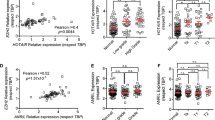Summary
The effects of combined RNA interference (RNAi) of human telomerase RNA (hTR) and human telomerase reverse transcriptase (hTERT) genes on telomerase activity in a bladder cancer cell line (BIU-87 cells) were investigated by using gene chip technology in vitro with an attempt to evaluate the role of RNAi in the gene therapy of bladder transitional cell cancer (BTCC). Three TR-specific double-stranded small interfering RNAs (siRNAs) and three TERT-specific double-stranded siRNAs were designed to target different regions of TR and TERT mRNA. The phTR-siRNA, phTERT-siRNA, and the combination of both plasmids phTR+phTERT-siRNA were transfected into BIU-87 cells. The expression of hTR and hTERT mRNA was detected by quantitative fluorescent reverse transcription-polymerase chain reaction, and a telomeric repeat amplification protocol was applied to detect telomerase activity. Growth inhibition of BIU-87 cells was measured by MTT assay. Gene chip analysis was performed to evaluate the effects of the combined RNAi of hTR+hTERT genes on telomerase activity and growth of BIU-87 cells in vitro. The results showed that the expression of hTERT and hTR mRNA was inhibited by pRNAT-hTERT-III, pRNAT-hTR-III, and pRNAT-hTR-III+hTERT-III in BIU-87 cells. The inhibition efficiency of pRNAT-hTERT-III, pRNAT-hTR-III, pRNAT-hTERT-III+pRNAT-hTR-III was 67% for TERT mRNA, 41% for TR mRNA, 57% for TR mRNA and 70% for TERT mRNA in BIU-87 cells respectively. The growth of BIU-87 cells was inhibited and telomerase activity was considerably decreased, especially in the cells treated with combined RNAi-hTR and -hTERT. Gene chip analysis revealed that 21 genes were down-regulated (ATM, BAX, BCL2, BCL2L1, BIRC5, CD44, CTNNB1, E2F1, JUN, MCAM, MTA1, MYC, NFKB1, NFKBIA, NME4, PNN, PNN, SERPINE1, THBS1, TNFRSF1A, and UCC1). The results indicated that hTR-siRNA and hTERT-siRNA, especially their combination, siRNA hTR+hTERT, specifically and effectively suppressed the expression of both hTR and hTERT mRNA and telomerase activity. Molecular biological mechanism by which combined siRNA-TR and -TERT inhibited telomerase activity and growth of BIU-87 cells in vitro may involve the down-regulation of the 21 genes.
Similar content being viewed by others
References
Nakatsukasa H, Onishi T, Kaneyoshi T, et al. Expression of telomerase-associated protein 1 and telomerase reverse transcriptase in hepatocellular carcinoma. Br J Cancer 2000,82(4):833–837
Lord RV, Salonga D, Danenberg KD, et al. Telomerase reverse transcriptase expression is increased early in the Barrett’s metaplasia, dysplasia, adenocarcinoma sequence. J Gastrointest Surg, 2000,4(2):135–142
Konagi Y, Kabayashi D, Yajima T, et al. Telomerase activity is down regulated via decreases in hTERT but not TEP1 mRNA or hTERC during the differentiation of leukemic cells. Anticancer Res, 2000,20(2A):773–778
Watanabe N. Telomerase, cell immortality and cancer Hokkaido Igaku Zasshi, 2001, 76(3):127–132
Rhya MS. Telomeres telomerase and immortality. J Natl Cancer Ins, 1995,87(12):884–894
Zou L, Zhang P, Luo C, et al. shRNA targeted hTERT suppress cell proliferation of bladder cancer by inhibiting telomerase activity. Cancer Chemother Pharmacol, 2006, 57(3):328–334
Ito H, Kyo S, Kanaya T, et al. Expression of human telomerase subunit and correlation with telomerase activity in urothelial cancer. Clin Cancer Res, 1998,4(7):1603–1608
Lancelin F, Anidjar M, Villette JM, et al. Telomerase activity as a potential marker in preneoplastic bladder lesions. BJU Int, 2000,85(4):526–531
Suzuki T, Suzuki Y, Fujioka T. Expression of the catalytic subunit associated with telomerase gene in human urinary bladder cancer. J Urol, 1999,162(6):2217–2220
Glasgow JN, Everts M, Curiel DT. Transductional targeting of adenovirus vectors for gene therapy. Cancer Gene Ther, 2006,13(9):830–844
Elbashir SM, Lendeckel W, Tuschl T. RNA interference is mediated by 21- and 22- nucleotide RNAs. Gene Dev, 2001,15(2):188–200
Oeggerli M, Tomovska S, Schraml P, et al. E2F3 amplification and overexpression is associated with invasive tumor growth and rapid tumor cell proliferation in urinary bladder cancer. Oncogene, 2004, 23(33):5616–5623
Wu X, Deng Y, Wang G, Tao K. Combining siRNAs at two different sites in the EGFR to suppress its expression, induce apoptosis, and enhance 5-fluorouracil sensitivity of colon cancer cells. J Surg Res, 2007,183(1):56–63
Lin Y, Uemura H, Fujinami K, et al. Telomerase activity in primary prostate cancer. J Urol, 1997,157(3):1161–1165
Wu KJ, Grandori C, Amacker M, et al. Direct activation of Tert transcription by c-myc. Nature Genet, 1999,21:220–224 (2)
Suenaga M, Yamaguchi A, Soda H, et al. Antiproliferative effects of Gefitinib are associated with suppression of E2F1 expression and telomerase activity. Anticancer research, 2006,26(5A):3387–3392
Pirocanac EC, Nassirpour R, Yang M, et al. Bax-induction gene therapy of pancreatic cancer. J Surg Res, 2002, 106(2):346–351
Malerba I, Gribaldo L, Diodovich C. Induction of apoptosis and inhibition of telomerase activity in human bone marrow and HL-60 p53 null cells treated with anti-cancer drugs. Toxicology in Vitro, 2005,19(4):523–532
Sandra Angèle, Alison Falconer, et al. ATM protein overexpression in prostate tumors. Anatomic Pathology, 2004,121(2):231–236
David Feldser, Margaret A. Strong, Carol W. Greider, et al. Ataxia telangiectasia mutated (Atm) is not required for telomerase-mediated elongation of short telomerase. Cancer Res, 2003(63):8188–8196
Shiloh Y. ATM and related protein kinases: safeguarding genome integrity. Nat Rev Cancer, 2003,3(3):155–168
Metcalfe JA, Parkhill J, Campbell L, et al. Accelerated telomere shortening in ataxia telangiectasia. Nat-Genet, 1996,13(3):350–353
Greenwell PW, Kronmoal SL, Porter SE. et al. TEL1, a gene involved in controlling telomere length in S. cerevisiae, is homologous to the human ataxia telangiectasia gene. Cell, 1995,82(5):823–829
DuBois ML, Haimberger ZW, Mclntosh MW, et al. A quantitative assay for telomere protection in Saccharomyces cerevisiae. Genetics, 2002,161(3):995–1013
Fujimoto K, Takahashi M. Telomerase activity in human leukemic cell lines is inhibited by antisense pentadecadeoxynucleotides targeted against C-myc mRNA. Biochem Biophys Res Commun, 2007,24(3):775–781
Latil A, Vidaud D, Valeri A, et al. hTERT expression correlates with Myc over-expression in human prostate cancer. Int J Cancer, 2000,89(2):172–1797
Author information
Authors and Affiliations
Corresponding author
Rights and permissions
About this article
Cite this article
Cheng, W., Wei, Z., Gao, J. et al. Effects of combined siRNA-TR and -TERT on telomerase activity and growth of bladder transitional cell cancer BIU-87 cells. J. Huazhong Univ. Sci. Technol. [Med. Sci.] 30, 391–396 (2010). https://doi.org/10.1007/s11596-010-0363-2
Received:
Published:
Issue Date:
DOI: https://doi.org/10.1007/s11596-010-0363-2




